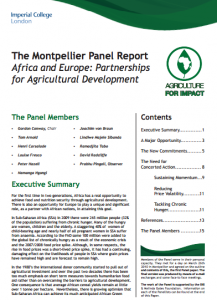For the first time in two generations, Africa has a real opportunity to achieve food and nutrition security through agricultural development. There is also an opportunity for Europe to play a unique and significant role, as a partner with African nations, in attaining this goal.
In Sub-Saharan Africa (SSA) in 2009 there were 265 million people (32% of the population) suffering from chronic hunger. Many of the hungry are women, children and the elderly. A staggering 40% of women of child-bearing age and nearly half of all pregnant women in SSA suffer from anaemia. According to the FAO some 100 million were added to the global list of chronically hungry as a result of the economic crisis and the 2007/2008 food price spike. Although, in some respects, the rise in food prices was a short-lived price spike, it has had a continuing, damaging effect on the livelihoods of people in SSA where grain prices have remained high and are forecast to remain high.
African leaders have a new and growing commitment to agricultural development and combating hunger. Members of the African Union are committed to increase resources for agriculture and rural development to at least 10% of national budgets within 5 years. In SSA average annual growth in GDP has been over 5% for the period 2000-2008, and in agriculture has been over 3%. This combination is creating opportunities in domestic, regional and international agricultural markets, especially where there are supportive, stable governments.
As a response to the 2007/8 crisis there has been a renewed global momentum to combat hunger. At the 2009 L’Aquila summit of the G8 $22.5 billion was pledged to this task, including $3.5 billion from the United States (US), and $3.8 billion from the European Commission, as well as significant commitments from several other European donors. Nevertheless, European donors could do more, commit more resources, and work more closely together to align and coordinate their actions to Africa’s emerging national, regional and cross-continent agendas. We believe the way forward is to build on the growing momentum of the Comprehensive African Agricultural Development Programme (CAADP), and to align aid to national African governmental strategies through a common vision and plan for agricultural development.
The opportunity for action is thus timely. The challenge is to ensure the momentum is sustained in terms of commitment and funding by the key African and European partners. We believe Europe is well placed to take the lead and drive forward change. In 2005/6 European support for agriculture began to increase. Today the European Union (EU) is responsible for over 60% of the world’s Overseas Development Assistance (ODA), including about $800 million per year to agricultural development in SSA. There are three areas that need urgent attention:
- Sustaining the momentum
- Reducing price volatility
- Tackling chronic hunger
Despite significant progress globally we have, on the one hand, a very top down global response characterised by strong rhetoric and the promises of large-scale funding and, on the other, a rich diversity of on-the-ground activities in sub-Saharan Africa undertaken by government and private agencies and NGOs but which remain uncoordinated. We believe there is a potentially dangerous gap between the two strands of activity. If we do not bridge the gap there is a risk that new investments will dissipate into more small scale activity, and we will not see the transformational change that is needed.







